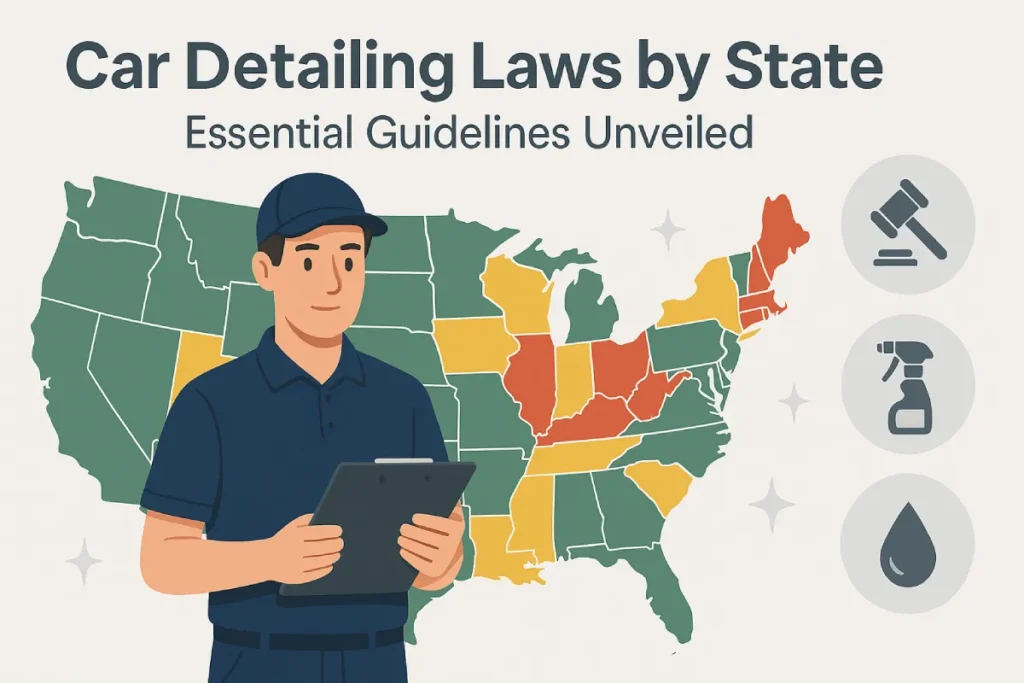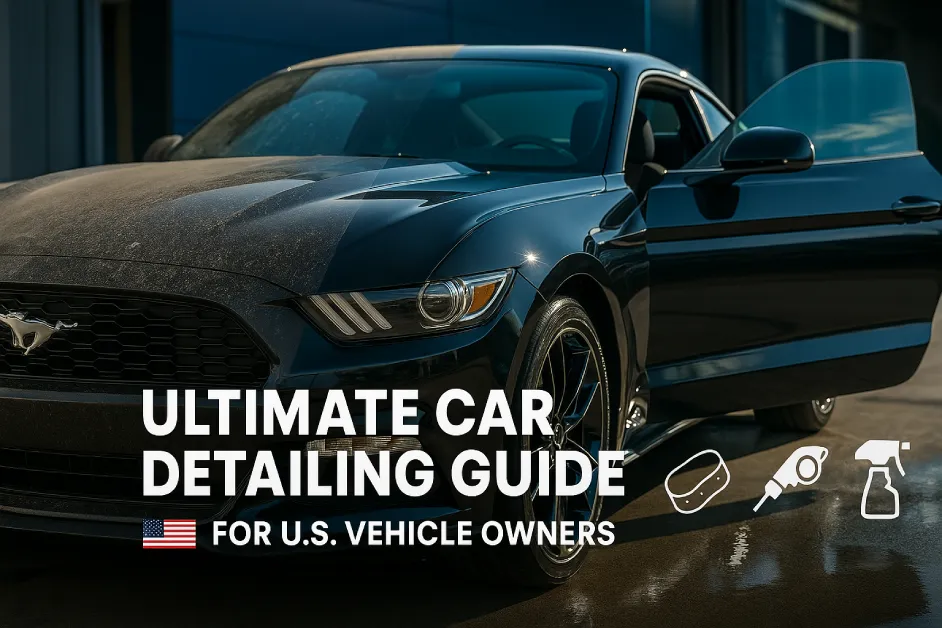If you run or work in an auto detailing shop, keeping your team safe isn’t just a good idea—it’s the law. OSHA safety requirements for auto detailing shops are designed to protect you and your employees from common risks like chemical exposure, slips, and heat stress.
Ignoring these rules can lead to serious injuries or costly fines. But don’t worry—understanding these requirements doesn’t have to be complicated. You’ll discover the key OSHA safety rules every auto detailing shop in Austin, Texas, must follow. By taking these steps, you’ll create a safer workplace, improve your shop’s reputation, and avoid unexpected penalties.
Keep reading to learn exactly what you need to do to stay compliant and protect your team.
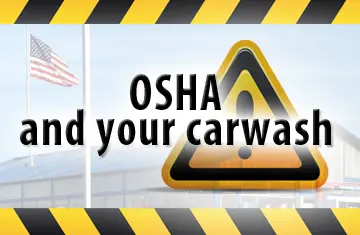
Credit: www.carwash.com
Key Osha Standards
Auto detailing shops face unique safety challenges. OSHA sets clear standards to protect workers in these environments. Following key OSHA standards helps reduce accidents and health risks.
These standards focus on personal protection, clear hazard communication, emergency readiness, ongoing safety training, and proper recordkeeping. Adhering to them creates a safer workplace for all employees.
Personal Protective Equipment
Workers must wear proper personal protective equipment (PPE) to avoid injuries. Gloves protect hands from chemicals and sharp tools. Safety glasses shield eyes from splashes and debris. Respirators may be needed for fumes or dust. Proper PPE use is vital for daily tasks in auto detailing shops.
Hazard Communication
All chemicals used must be clearly labeled. Safety Data Sheets (SDS) should be available for each substance. Employees need training on chemical hazards and safe handling. This prevents accidental exposure and ensures a quick response in case of spills or contact.
Emergency Action Plans
Every shop must have an emergency action plan. This plan details evacuation routes and emergency contacts. Staff should know what to do in fires, chemical spills, or injuries. Regular drills help keep everyone prepared and calm during emergencies.
Workplace Safety Training
Regular safety training keeps workers informed and alert. Training covers equipment use, chemical safety, and PPE. New hires should receive orientation on safety rules. Ongoing sessions refresh knowledge and introduce new safety measures. Well-trained employees reduce workplace accidents.
Recordkeeping Requirements
OSHA requires detailed records of work-related injuries and illnesses. These records help track safety performance and identify hazards. Documentation must be accurate and up to date. Keeping records supports compliance and helps improve shop safety policies.
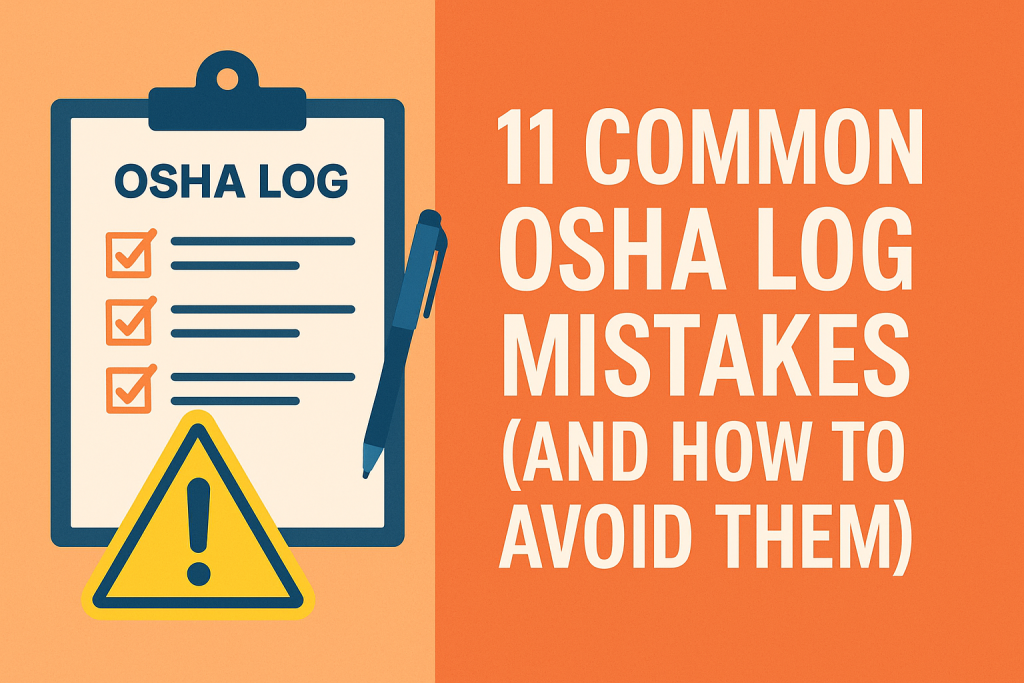
Credit: walivebig.com
Chemical Safety In Auto Detailing
Chemicals are common in auto detailing shops. Workers use cleaners, waxes, and solvents daily. These substances can be harmful without proper care. Following OSHA safety rules helps protect everyone from accidents and health risks. Understanding chemical safety is key to a safe workplace.
Handling Hazardous Materials
Use gloves and goggles when handling chemicals. Avoid direct skin contact and inhaling fumes. Always work in well-ventilated areas. Never mix chemicals unless the instructions allow it. Proper handling reduces spills and accidents.
Safety Data Sheets
Every chemical must have a Safety Data Sheet (SDS). The SDS shows hazards, first aid, and handling tips. Keep these sheets accessible to all workers. Train staff to read and understand SDS details. This knowledge helps prevent injuries and misuse.
Proper Labeling And Storage
Label all chemical containers clearly with contents and hazards. Store chemicals in cool, dry places away from heat and sunlight. Separate incompatible chemicals to avoid dangerous reactions. Use locked cabinets for toxic substances. Proper labeling and storage keep the shop safe.
Heat Stress Prevention
Heat stress poses a serious risk in auto detailing shops. Workers often spend hours in hot environments. This exposure can lead to heat-related illnesses. Preventing heat stress protects health and boosts productivity. Following OSHA guidelines helps keep workers safe and comfortable.
Recognizing Heat-related Illnesses
Heat exhaustion and heat stroke are common heat illnesses. Symptoms include heavy sweating, weakness, dizziness, and headache. Confusion and nausea are signs of severe heat stress. Early recognition allows quick action. Immediate care prevents serious health problems.
Heat Acclimatization Strategies
Gradual exposure to heat helps the body adjust. Start with short work periods in hot conditions. Increase duration to 7 to 14 days. Acclimatized workers sweat more efficiently. They also maintain better body temperature control. This reduces the risk of heat illness during long shifts.
Work Practice Controls
Provide frequent breaks in shaded or cooled areas. Encourage workers to drink water regularly. Avoid caffeine and sugary drinks. Schedule heavy tasks during cooler parts of the day. Use fans or ventilation to improve airflow. Train workers on heat stress signs and prevention methods.
Ventilation And Respiratory Protection
Proper ventilation and respiratory protection are critical in auto detailing shops. These measures help reduce harmful airborne particles and fumes. Ensuring clean air protects workers from respiratory issues and long-term health risks. Auto detailing involves chemicals and welding, which can release dangerous fumes. Following OSHA safety requirements creates a safer work environment and prevents exposure to toxic substances.
Managing Welding And Fume Hazards
Welding produces hazardous fumes that can harm workers. Proper ventilation systems remove these fumes from the work area. Local exhaust ventilation near the welding site is effective. Workers should avoid inhaling smoke and gases during welding. Regular inspection of ventilation equipment ensures it works correctly. Keeping the air clean reduces the risk of lung damage and other health problems.
Respirator Selection And Use
Choosing the right respirator depends on the type of hazard present. Respirators must fit properly to offer full protection. Employers must provide training on respirator use and maintenance. Workers should use respirators during tasks with high dust or chemical exposure. Regular checks of respirators prevent leaks and failures. Clean respirators and replace filters as recommended by OSHA.
Maintaining Air Quality
Good air quality prevents illness and improves worker comfort. Ventilation systems must circulate fresh air throughout the shop. Air filters should be cleaned or replaced regularly. Monitor air quality to detect harmful levels of dust and fumes. Use air purifiers or exhaust fans to maintain a safe atmosphere. Proper housekeeping reduces dust buildup and improves overall air quality.
Training And Communication
Training and communication form the backbone of workplace safety in auto detailing shops. Proper training ensures every employee understands the hazards they face daily. Clear communication helps prevent accidents and promotes a safety-first culture. Both elements help meet OSHA safety requirements effectively and keep workers safe.
Language And Comprehension Considerations
Many auto detailing shops employ workers who speak different languages. Training materials and safety instructions must be easy to understand. Use simple words and short sentences. Provide translations or visual aids if needed. Confirm that employees fully grasp safety rules before they start work. This approach reduces misunderstandings and improves overall safety compliance.
Regular Safety Drills
Conducting safety drills regularly prepares employees for emergencies. Drills should cover fire, chemical spills, and equipment hazards. Practice helps workers respond quickly and correctly under pressure. Schedule drills at least quarterly to keep safety skills fresh. Track participation and provide feedback to improve future drills. Regular exercises build confidence and reduces workplace injuries.
Employee Rights And Reporting
Employees must know their rights under OSHA regulations. They can report unsafe conditions without fear of retaliation. Training should include how to report hazards or incidents properly. Encourage open communication between staff and management. A safe environment depends on workers speaking up about risks. Management must act promptly to address reported safety concerns.
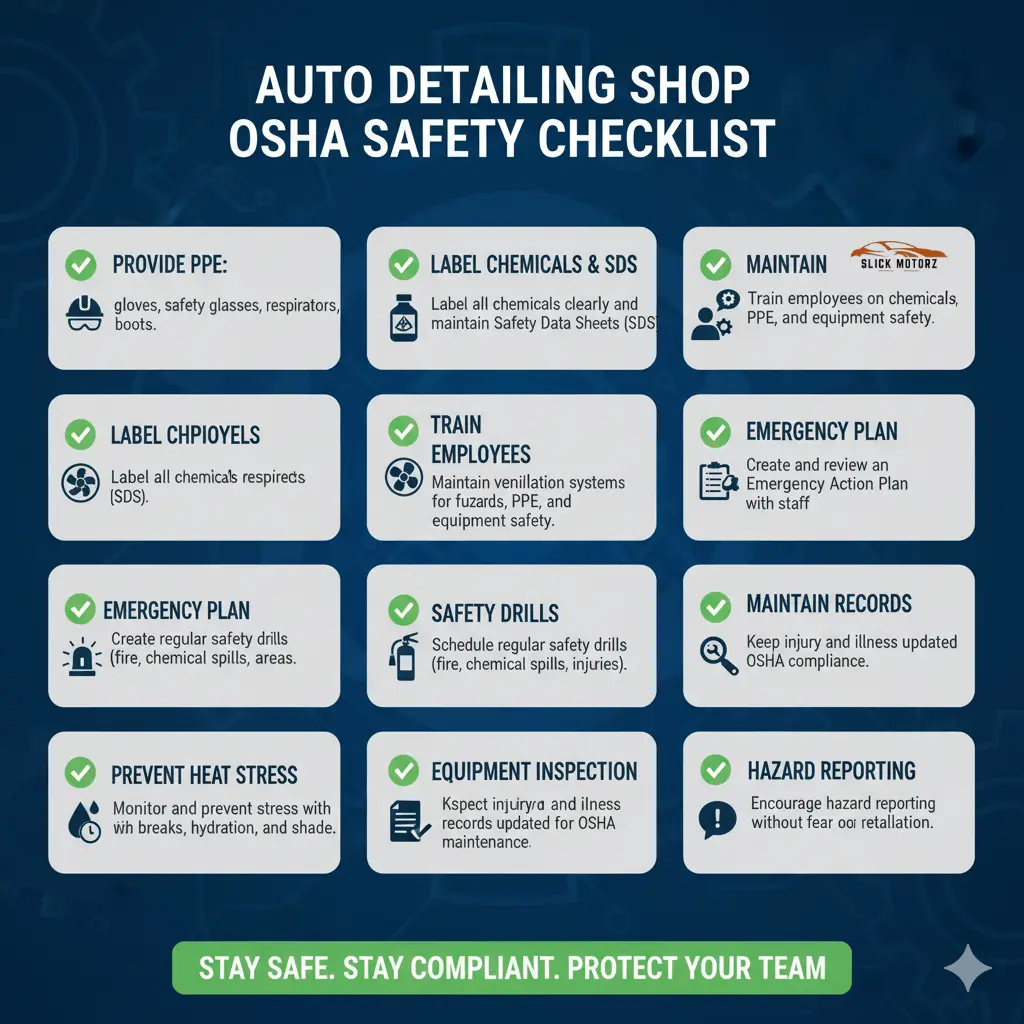
Equipment Safety
Equipment safety is vital in auto detailing shops to protect workers and ensure smooth operations. Proper handling and maintenance of machines reduces accidents and downtime. Following OSHA safety requirements helps create a safe work environment. This section covers key points about equipment safety in auto detailing shops.
Safe Use Of Powered Industrial Trucks
Powered industrial trucks, like forklifts, help move heavy items quickly. Operators must be trained and certified before use. Always check the load capacity and avoid overloading. Drive at safe speeds and watch for pedestrians. Use horns at blind spots and keep aisles clear. Follow OSHA guidelines strictly to prevent injuries.
Maintenance And Inspections
Regular maintenance keeps equipment in good condition. Schedule daily inspections to spot problems early. Look for leaks, worn parts, or loose bolts. Fix issues immediately to avoid breakdowns. Keep records of all maintenance and repairs. OSHA requires shops to maintain safe and reliable tools.
Proper PPE for Equipment Operation
Personal protective equipment (PPE) is essential during equipment use. Wear gloves to protect your hands from cuts and burns. Safety goggles shield eyes from splashes and debris. Hearing protection helps reduce noise exposure. Use steel-toed boots to guard feet from heavy objects. OSHA mandates proper PPE to reduce workplace injuries.
Frequently Asked Questions
What Is The 80% Rule for OSHA?
The 80% rule for OSHA means employers must limit workers’ exposure to hazardous substances to 80% of the permissible exposure limit. This helps protect employees from health risks by ensuring exposure stays below harmful levels during an 8-hour workday.
What Is The Required PPE in The Auto Shop?
Required PPE in an auto shop includes safety glasses, gloves, helmets with filters, and flame-resistant clothing. Proper ventilation reduces fumes.
What are the five OSHA safety Requirements?
Five OSHA safety requirements include providing Personal Protective Equipment (PPE), implementing a Hazard Communication program, establishing an Emergency Action Plan, conducting regular safety training, and keeping accurate injury and illness records. These ensure a safe workplace and compliance with OSHA standards.
What Type Of Safety Will Be Taken In An Automotive Workshop?
Automotive workshops ensure safety by providing PPE like gloves and helmets, maintaining ventilation, following OSHA hazard communication, and conducting regular safety training. They also implement emergency action plans and keep accurate injury records to protect workers from risks and hazards.
Conclusion
Following OSHA safety rules keeps auto detailing shops safe and healthy. Use proper protective gear every day. Train workers regularly on hazards and safety steps. Keep areas clean and well-ventilated to reduce risks. Have clear emergency plans ready for quick action.
Regular safety checks help catch problems early. A safe workplace protects workers and boosts shop success. Stay aware, stay prepared, and prioritize safety always.










